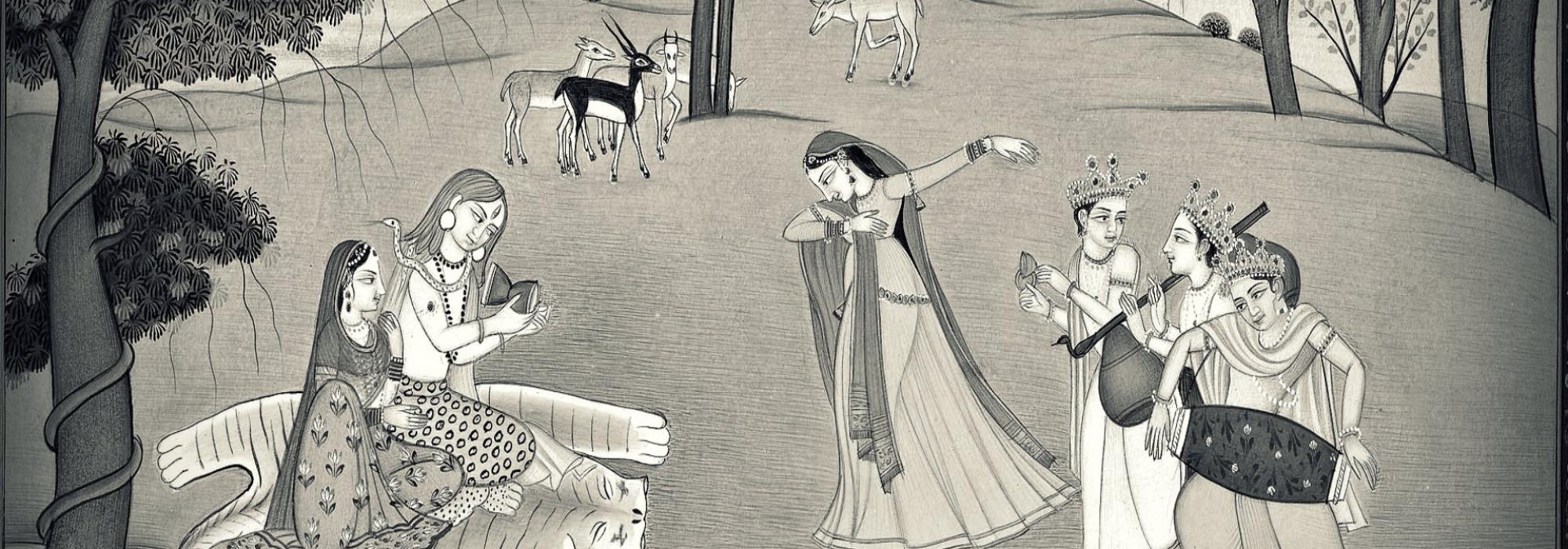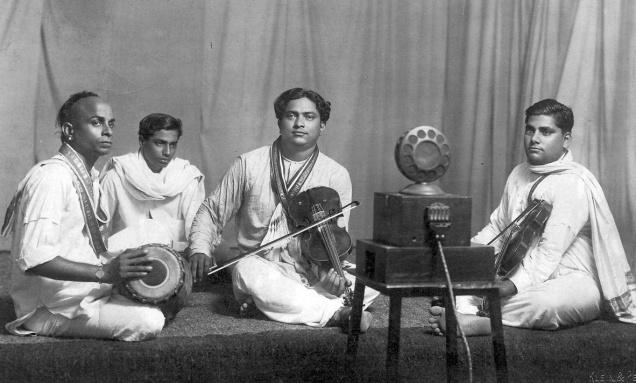Sangitaratna Chintalapalli Venkataraya was a tiger of the yesteryears. Though the usage of ‘tiger’ as a simile for a musician may be debated, the tiger is renowned for representing courage and fortitude. This was the prowess of Venkataraya. He belonged to the line of great vidvans of music. His training in tradition and the craft of music was of a high degree. When a person acquires learning by his own efforts, when the mind becomes filled with enthusiasm and brightness, a zeal arises to create waves. Even after he was ninety, Venkataraya had this kind of zeal.
His younger brother was Venkatachalayya. At one point, both the brothers would sing together. What I recollect now is an episode that took place about forty-six or forty-seven years ago. The two brothers sang the Tyagaraja kriti ‘Ennaga manasuku rani pannagashayi sogasu’ in Nilambari raga. There were tears in the eyes of the singers. And tears flowed in a constant stream from the eyes of the listeners. That was the boundary-line of musical experience.
In a beautiful stotra composed by Bhagavan Shankaracharya, the imagery of Gauri devi, the universal mother, is particularly memorable:
नखमुखमुखरितवीणा-
नादरसास्वादनवरसोल्लासम् |
वीणावादनवेला
कंपितशिरसं नमामि मातङ्गीम् ||
Playing the vina with her fingers, herself experiencing the beautiful music, the universal mother Lalitamba was filled with joy. In that joy, forgetting herself, she nodded her head like she was responding to another’s pleasant music.
This is a statement of personal experience. Personal experience in music is one such thing. The command that Venkataraya had over music was of this variety.
~
One evening, my friend C. Krishna Rao and I were going towards Lalbagh to get some fresh air. Venkataraya was standing in front of the temple on Lalbagh Fort Road and chatting with someone. I told Krishna Rao, “We should kidnap this Venkataraya chap right at this moment.”
Krishna Rao immediately reversed the car. We went to where Venkataraya was standing and asked him to get into the car.
Venkataraya: “How can I come now, sir? I was discussing about the Rama utsava (festival) with this friend of mine.”
Me: “We too are calling you to the utsava!”
Thus we forcibly abducted him. Seating him in the car, we went to Lalbagh and filled our tummies with our favorite delicacies. Soon after, we boarded the car and reached the Vijaya College of Music. The principal of the college, Narayanaswami Bhagavathar, was delighted. “Oh my! Venkatarayappa!” he said, while the other said, “Oh my! Narayanaswami!” and they hugged each other tight. After that, this ensued:
Narayanaswami: “Venkatarayappa, how many days has it been since I heard you sing (Raga) Mukhari!”
Venkataraya: “Narayanaswami, how many years has it been since I heard your violin!”
Then they sat down to make music. Venkataraya sang the Mukhari kriti, ‘Kshina mai.’ Narayanaswami Bhagavathar accompanied him on the violin. For how long we were immersed in joy, we didn’t see the time then. For not less than two hours, we had the experience of the raga structure of Mukhari. Normally designated as a raga that evokes the emotion of sorrow, there was such evocative finesse in that Mukhari. Such flirtatious variations! We were able to experience all of this when Venkataraya delineated the raga.
Some years ago, a Sangita Vidwat Sammelana (Conference of Music Scholarship) was held. T. Chowdiah was the convener. Mysore Vasudevacharya was honored on the first day of the event. The second evening, there was a concert and someone was singing. Someone was accompanying the singer. Venkataraya came there. After he was seated, there was no trace of joy on his face for the next fifteen or twenty minutes. The fidgeting of his fingers and his facial expressions showed that he was dissatisfied. Seated at some distance from him, I walked up to him and took a place by his side. A further four or five minutes passed. Venkataraya said, “Hush, hush!” I asked him, “What happened, Venkatarayappa?” He banged his forehead and said, “I’m unable to tolerate it sir, these sons of bitches…do all sorts of things. What a time has come for music! People like me should no longer be there.” Saying this, he went away. There was a mridanga in the concert but the sound that hit the ears was that of a box made from nutmeg. One can imagine the rest of the fare. Venkataraya’s grasp of the touch of music was so subtle and delicate.
~
Another day—in 1932-33—Chintalapalli Venkataraya’s children had organized a musical concert of Ramachandra Rao in the Kannada Sahitya Parishad. He had recently received an award from the Maharaja of Mysore. That evening, people filled up not only the main hall of the Parishad, but also the verandah, the empty space in front of it, as well as the premises of the Sanskrit college facing it. About the time that the concert was supposed to start, Ramachandra Rao could not make it. His father, Venkataraya came there and said:
Venkataraya: “The boy has fever. He is lying down, sapped of all strength.”
Me: “It is appropriate for him to take rest. But look at all the people who have gathered here. How can I pacify such a big crowd?”
Venkataraya’s face displayed helplessness.
Venkataraya: “What can I do, sir?”
Me: “Hasege banni” and then I said, “Hasege baare kusumanetre…”
[Note: Translated, this is a play on the Kannada word ‘Hase,’ meaning a wooden plank where a couple is seated during their wedding. In this context, D.V. Gundappa in teasing humour asks Chintalapalli Venkataraya to take the “hase,” referring to the original musician’s spot on the dais, almost as if he were going to get married. So, the complete phrase, ‘Hasege bare kusumanetre” refers to D.V. Gundappa teasing Venkataraya as if he was addressing a ‘kusumanetre,’ the flower-eyed bride to sit down on the ‘hase.’ In other words, a proposal for marriage.]
Venkataraya: “Oh, but I have become old!”
Me: “You hail from Hunasanahalli, the village of tamarind. It is said that the older the tamarind tree, the better is the fruit!”
Giving in to my pressure, Venkataraya agreed to sing and sat down. On that occasion, there were highly skilled accompanists on the violin and the mridanga. Venkataraya started off with a varnam and then sang a couple of well-known kritis. Then he started working his magic. If memory serves me right, it was a song in raga Bhairavi. After the first two or three rhythmic cycles, the accompanying violinist placed his violin down, folded his hands, and looked at Venkataraya’s face. At the end of every other rhythmic cycle, the violinist, after a decent bit of bowing, would keep his violin down and bow to Venkataraya with folded palms. This went on for a while. After this, Venkataraya sang a couple of devaranamas and the mangalam.
Chintalapalli Venkataraya knew hundreds of devaranamas (Kannada devotional songs) from memory. His singing of devaranamas was not from the throat but from the heart. It was not one of expertise in the grammar of music but one of ripening of the mind.
~
When he was ninety-two or ninety-three, he graced my house with a visit one day. As we were exchanging pleasantries, the topic of Sri raga came up. Then Venkataraya sang the kriti:
Edira-a-a-a
Ni divyarupamu
A most exquisite composition. Even at that age, the physique of his voice was mellifluous and pliant. Venkataraya told me that one of his ancestors had composed that song. Venkataraya’s ancestors were musicians. His entire family imbued music.
I had requested him several times to “Collect all the compositions by your ancestors. Write down the musical notations. We’ll arrange for its publication.” And each time he would say, “Oh, I will bring it within a week. I’ve been at it all this while. It has to be done sir, indeed it has to be done!”
To let time pass thus is also an artistic skill.
By nature, Venkataraya was a confident man. While speaking with friends, he exhibited a great deal of politeness and humility but at heart, the thought of “Who’s bigger? Who’s smaller?” filled him. This is the reason he never struggled a great deal for patronage. Since he was satisfied with what little he had – though he was in no way less competent – he could never gain the name and fame of some of his contemporaries. Contentment with what God had given him, humor, deep friendships, integrity in art – in these, his life was fulfilled.
This is the sixteenth chapter from D V Gundappa’s magnum-opus Jnapakachitrashaale (Volume 2) – Kalopasakaru. Translator's notes in square brackets. Thanks to Arjun Bharadwaj and Sandeep Balakrishna for their excellent edits to the translation.















































